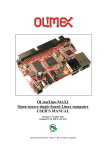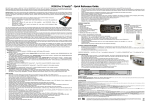Download Rosewill RNX-MININ1 User manual
Transcript
Wireless N Adapter RNX-MiniN1 User Manual Wireless N Adapter RNX-MiniN1 User Manual FCC STATEMENT This equipment has been tested and found to comply with the limits for a Class B digital device, pursuant to part 15 of the FCC Rules. These limits are designed to pro-vide reasonable protection against harmful interference in a residential installation. This equipment generates, uses and can radiate radio frequency energy and, if not in-stalled and used in accordance with the instructions, may cause harmful interference to radio communications. However, there is no guarantee that interference will not occur in a particular installation. If this equipment does cause harmful interference to radio or television reception, which can be determined by turning the equipment off and on, the user is encouraged to try to correct the interference by one or more of the following measures: • Reorient or relocate the receiving antenna. • Increase the separation between the equipment and receiver. • Connect the equipment into an outlet on a circuit different from that to which the receiver is connected. • Consult the dealer or an experienced radio/ TV technician for help. This device complies with part 15 of the FCC Rules. Operation is subject to the following two conditions: 1) This device may not cause harmful interference. 2) This device must accept any interference received, including interference that may cause undesired operation. Any changes or modifications not expressly approved by the party responsible for compliance could void the user’s authority to operate the equipment. FCC RF Radiation Exposure Statement This equipment complies with FCC RF radiation exposure limits set forth for an uncontrolled environment. This device and its antenna must not be co-located or operating in conjunction with any other antenna or transmitter. “To comply with FCC RF exposure compliance requirements, this grant is applicable to only Mobile Configurations. The antennas used for this transmitter must be installed to provide a separation distance of at least 20 cm from all persons and must not be co-located or operating in conjunction with any other antenna or transmitter.” CE Mark Warning This is a class B product. In a domestic environment, this product may cause radio interference, in which case the user may be required to take adequate measures. National Restrictions 2400.0-2483.5 MHz Country Restriction Reason/remark Bulgaria France General authorization required for outdoor use and public service Outdoor use limited to 10 mW EIRP. Military Radiolocation use. Refarming of the 2.4 GHz band has within the band 2454-2483.5 MHz been ongoing in recent years to allow current relaxed regulation. Full implementation planned 2012 2 Wireless N Adapter RNX-MiniN1 User Manual Italy If used outside of own premises, general authorization is required Luxembourg General authorization required for network and service supply(not for spectrum) Norway Implemented This subsection does not apply for the geographical area within a radius of 20 km from the centre of Ny-Ålesund Russian Only for indoor applications Federation Note: Please don’t use the product outdoors in France. 3 Wireless N Adapter RNX-MiniN1 User Manual Table of Content Chapter 1 Overview .......................................................................................................5 1.1 Package Content.........................................................................................5 1.2 Overview of the Product ............................................................................5 1.3 Features ......................................................................................................5 1.4 Product Specification .................................................................................6 1.5 System Requirement ..................................................................................6 Chapter 2 Installation Guide ..........................................................................................7 2.1 Hardware Installation.................................................................................7 2.2 Installation using Driver CD:.....................................................................8 Chapter 3 Wireless Connection Guide......................................................................... 11 3.1 Connecting with Microsoft Zero Configuration tool (Win XP) .................... 11 3.2 Connecting with Window 7...........................................................................12 3.3 Connecting with Rosewill Wireless Utility...................................................14 Chapter 4 Rosewill Utility Configuration – Station Mode ..........................................16 4.1 General.....................................................................................................16 4.2 Profile.......................................................................................................17 4.2.1 Add.......................................................................................................18 4.2.2 Remove ................................................................................................19 4.2.3 Edit.......................................................................................................19 4.2.4 Duplicate ..............................................................................................20 4.2.5 Set default ............................................................................................20 4.3 Available Network ...................................................................................21 4.4 Status........................................................................................................22 4.5 Statistics ...................................................................................................22 4.6 Wi-Fi Protect Setup..................................................................................23 4.6.1 Method 1 PIN Input Config (PIN) .......................................................23 4.6.2 Method 2 Push Button .........................................................................24 4.7 Virtual Wifi Allowed – (Windows 7 only) ..............................................26 4.7.1 Enabling the Virtual WiFi ....................................................................26 Chapter 5 Configuration – Access Point Mode ...........................................................30 5.1 General.....................................................................................................30 5.2 Advanced .................................................................................................32 5.3 Statistics ...................................................................................................33 5.4 ICS ...........................................................................................................34 FAQ..............................................................................................................................36 4 Wireless N Adapter RNX-MiniN1 User Manual Chapter 1 Overview Thank you for choosing Rosewill’s 802.11n Wireless USB adapter – RNX-MININ1. This chapter is to introduce you more about this Wireless Adapter. 1.1 Package Content Before getting started, please verify that your package includes the following items: 1. Rosewill 802.11n Wireless USB Adapter x 1 2. Quick Installation Guide x 1 3. Resource CD x 1, including: z Rosewill Wireless N Client Utility and Driver z User Manual Note: Make sure that the package contains the above items. If any of the listed items are damaged or missing, please contact with your distributor. 1.2 Overview of the Product The adapter is an 802.11n client device; it is designed to provide a high-speed and unrivaled wireless performance for your computer or notebook. With a faster wireless connection, you can get a better Internet experience, such as downloading, gaming, video streaming and so on. With the 802.11n technology, the RNX-MININ1 allows high packet transfer rate of up to 150Mbps for maximum download throughput. It can also interoperate with other wireless (802.11b, 802.11g). The adapter supports WEP, WPA and WPA2 encryption to prevent outside intrusion and protect your personal information from being exposed. The adapter is easy to install and manage. The Quick Setup guides you step-by-step through the installation process; the Rosewill Wireless N Client Utility helps you create a wireless connection immediately. With unmatched wireless performance, reception, and security protection, the RNX-MININ1 is also designed to be one of the smallest size wireless adapter so you can use without any interference. It is the best choice for easily adding or upgrading wireless connectivity to your notebook and computer. 1.3 Features z Comply with IEEE 802.11b/g/n standards with up to 150Mbps data transfer speed. z Ultra-Nano size design with USB 2.0/1.1 interface. z Supports QoS Enhancement (WMM) for multimedia applications’ smoothness z High level of security with Wireless encryption of 64/128-bit WEP, WPA, WPA2, and IEEE802.1x functions. 5 Wireless N Adapter RNX-MiniN1 z User Manual Runs under most popular operating systems: Windows XP/Vista/7 (32/64 bits), Mac OS X and more. z Supports Software WPS (WiFi Protected Setup) connection. z Green Energy Saving: supports auto transmit power adjustment and idle energy auto control. 1.4 Product Specification Chipset Realtek RTL8188CUS Standard IEEE 802.11b/g/n; IEEE 802.11e QoS Enhancement (WMM); IEEE 802.11h TPC, Spectrum Measurement Bus Type USB 2.0 Type A Frequency Band 2.4000~2.4835GHz (Industrial Scientific Medical Band) Data Rate 11b: 1/2/5.5/11Mbps; 11g: 6/9/12/24/36/48/54Mbps 11n (20MHz): MCS0-7, up to 72Mbps 11n (40MHz): MCS0-7, up to 150Mbps Output Power 11b: 17±1.5dBm , 11g: 15±1.5dBm, 11n: 14±1.5dBm Receive Sensitivity 11b@11Mbps: -81±2dBm; 11g@54Mbps: -71±2dBm 11n(20MHz)@MCS7: -68±2dBm; 11n(40MHz)@MCS7: -64±2dBm Security WEP 64/128, WPA, WPA2 and IEEE 802.1x Antenna Internal Antenna (1T1R) OS support Windows XP/Vista/7; Linux Kernel 2.6.x; Mac OS X 10.4~10.6 Dimension 0.7” x 0.2” x 0.5” (18 x 6 x 14 mm) Temperature Operating: 32~104°F (0~40°C); Storage: -4~140°F (-20~60°C) Humidity Operating: 10~90% (Non-Condensing); Storage: Max. 95% (Non-Condensing) 1.5 System Requirement You must have at least the following z A laptop computer/desktop PC with an available USB port z At least a 300MHz processor and 32MB of memory z Windows OS for Win98SE, ME, 2000, XP, Vista, 7 or Mac OS X 10.4~10.6 z A CD-ROM Drive z USB controller properly installed and working in the computer z A 802.11n、802.11g or 802.11b Wireless Access Point/Router (for infrastructure Mode) or another 802.11n、802.11g or 802.11b wireless adapter (for Ad-Hoc; Peer-to-Peer networking mode). 6 Wireless N Adapter RNX-MiniN1 User Manual Chapter 2 Installation Guide 2.1 Hardware Installation z Please first insert the RNX-MiniN1 into your PC or NB USB slot. z If the following window popup, please click Cancel or Close: Under Win XP Under Windows Vista/Win7 7 Wireless N Adapter RNX-MiniN1 2.2 User Manual Installation using Driver CD: Please insert the CD into your CD-rom drive Click on the “Driver Installation” option when the Smart Wizard page popup. If the program didn’t run automatically, please double click on the Setup.exe in the CD to start the process. 8 Wireless N Adapter RNX-MiniN1 User Manual Click Yes if the following window popup For WinXP, you may need to select your desired Language of installtion. For Win7, the program will uses your current language as default setting. Select Next. 9 Wireless N Adapter RNX-MiniN1 User Manual Select “Yes, I want to restart my computer now.” Then click Finish. Upon restart, your installation is now ready. if you see below window popup, please select install this driver software anyway. Win7 Win XP 10 Wireless N Adapter RNX-MiniN1 User Manual Chapter 3 Wireless Connection Guide This chapter describes how to configure your Adapter for wireless connectivity on your Wireless Local Area Network (WLAN) and use the data security encryption features. After Installing the Adapter, the Adapter’s tray icon will appear in your system tray. It appears at the bottom of the screen, and shows the signal strength using color and the received signal strength indication (RSSI). In the following instruction for making a network connection, we use the provided Utility to configure your wireless network settings. Note: You could use either the software we provide or Microsoft Zero Configuration tool to configure this adapter. 3.1 Connecting with Microsoft Zero Configuration tool (Win XP) z After specifying the Microsoft Zero Configuration tool to configure your wireless icon on system tray. Select “View Available Wireless network, right click on the Networks” to specify your wireless network. z The tool shows the available wireless networks. Select your demanding network to connect with. z If prompted, enter the password/network key for your wireless network and click the 11 Wireless N Adapter RNX-MiniN1 User Manual Connect button. 3.2 Connecting with Window 7 You can easily access to wireless with Win7. First, move your mouse to lower right hand corner as below and click on the icon where arrow pointing to. Click Refresh to get an update of your Wireless Network Connection. This should help you search the SSID of the network you want to connect to. 12 Wireless N Adapter RNX-MiniN1 User Manual Select your desired SSID, then Click “Connect”. You will be prompt to ask you entering the network security key. Once entered, please click OK to complete. 13 Wireless N Adapter RNX-MiniN1 User Manual You should see below in a very short period and find out whether you are connected or now. 3.3 Connecting with Rosewill Wireless Utility We also provide this Utility for users to connect to a wireless network easily. It provides more information and configuration for this adapter. As default, the Utility is started automatically upon starting your computer and connects to a connectable wireless network with best signal strength and with no security setting. 1. First Select the Available Network option: 2. You will see a list of the SSID that your wireless adapter has scanned in your surrounding area. You can also “Refresh” to see the most updated list. Select your desired SSID (the one you want to link with). 3. Click Add to Profile. 14 Wireless N Adapter RNX-MiniN1 User Manual After click “Add to Profile”, you will see the next window “Wireless Network Properties” popup with your current wireless signal setting. (RNX-MiniN1 will detect automatically the current encryption setting of your SSID). So after the “Wireless Network Properties” popup, all you need to do is to enter the password of your SSID and click OK to continue. When done, your wireless adapter will automatically connect to this SSID. However, Please do make sure returning to “Profile” and set your SSID Profile as your default. So your utility will remember for the future to link to this SSID when computer is Power-On. Now you have completed the setup of your wireless network. You should be ready to surf! 15 Wireless N Adapter RNX-MiniN1 User Manual Chapter 4 Rosewill Utility Configuration – Station Mode The Wireless Adapter provides two modes: Station mode and Access Point mode, the default is Station mode under Window XP and Windows 7. You can select connect wirelessly to your Wireless router/AP to connect to Internet in station mode. But in the Access Point mode, the wireless adapter act as a wireless access point which can share Internet connection with others. (Access Point Mode requires Wired Connection) 4.1 General The General tab displays current basic wireless connection information. General Information 16 Wireless N Adapter RNX-MiniN1 User Manual z Status: Wireless network Associated, Ad-hoc Mode or Not Associated. z Speed: The data Tx rate and Rx rate of the current connection. z Type: The type of the current wireless connection , Infrastructures or ad hoc z Encryption: Current encryption. z SSID: The unique name of the wireless network to which the wireless adapter is connecting. z Signal Strength: The signal quality of the current connection. z Link Quality: The link quality of the current wireless connection. Network Address z MAC Address: The MAC Address of the Adapter. z IP Address: The IP Address of the Adapter. (This is assigned by the wireless router) z Subnet Mask: The Subnet Mask of the Adapter. z Default Gateway: The Default Gateway address of the Adapter. (This is normally the IP address of your wireless router) Others z Show Tray Icon: Show USB Wireless LAN Utility icon in the windows taskbar notification area. z Disable Adapter: Disable the wireless adapter. z Radio off: Turn off the radio of the wireless adapter. 4.2 Profile Using the Profile tab, you can Add, Remove, Edit, Duplicate, and Set Default a profile. 17 Wireless N Adapter RNX-MiniN1 4.2.1 z User Manual Add Create a new Infrastructure mode profile If you want your wireless computers to communicate with other computers on your wired network via a wireless access point. Click the Add button to create a new infrastructure profile. When the Network Info dialog box appears, enter a name for the new profile. Enter the Network SSID. The Network Authentication and Data Encryption can be auto-deteced. So you only need to key-in the Network Key. Then click OK button. z Create a new ad-hoc mode profile If you want your wireless computers communicate with each other directly, click the Add button to create a new ad-hoc profile. Then, check on below option: then select the correct operating channel for your network from the Channel drop-down menu. 18 Wireless N Adapter RNX-MiniN1 User Manual The Network Authentication and Data Encryption can be auto-deteced. So you only need to key-in the Network Key. Then click OK button. 4.2.2 Remove Select a profile and click Remove button to delete this profile. 4.2.3 Edit Select a profile and click Edit button to edit this profile. 19 Wireless N Adapter RNX-MiniN1 User Manual Modify the profile information according to your demand. 4.2.4 Duplicate Select a profile which you want to copy and then click Duplicate Import the new profile name in the popup window blank 4.2.5 Set default When you want to make one profile as a default wireless connection, you should select the profile and click Set default button. The wireless adapter will use this profile to connect to wireless network automatically when the utility running next time. 20 Wireless N Adapter RNX-MiniN1 4.3 User Manual Available Network The Available Network tab displays a list of networks for available wireless connection Select the network to which you wish to connect. Then click “Add to Profile” 21 Wireless N Adapter RNX-MiniN1 User Manual The Network Authentication and Data Encryption can be auto-deteced. So you only need to key-in the Network Key. Then click OK button. 4.4 Status The Status tab displays the detailed information of current device and wireless connection. 4.5 Statistics The Statistics tab display the stat. value of current wireless connection Tx and Rx, you can 22 Wireless N Adapter RNX-MiniN1 User Manual click Reset button to reset value and restart to count. 4.6 Wi-Fi Protect Setup 4.6.1 Method 1 PIN Input Config (PIN) 1. Input the Wireless Adapter’s PIN Code into your wireless router and click Start PIN in 23 Wireless N Adapter RNX-MiniN1 User Manual the Wireless-Router WPS configuration page 2. Click Pin Input Config(PIN) in your computer. 3. Select one WPS AP which you want connect to and click Select button 4. Please wait when the PIN Method Window pop-up appear, the secure connection between AP and wireless adapter will be founded automatically. 4.6.2 1. Method 2 Push Button First, press the WPS buttom on your Wireless Router. 24 Wireless N Adapter RNX-MiniN1 User Manual 2. Click Push Button Config(PBC) on Wi-Fi Protect Setup page 3. Please wait when the PBC method window pop-up appear, the secure connection between wireless router and Wireless Adapter will be founded automatically. 25 Wireless N Adapter RNX-MiniN1 User Manual Remark If there is more than one AP on the PBC mode, there will be session overlap. Please using method 1 PIN Input Config(PIN) or wait for a while push the button again. 4.7 Virtual Wifi Allowed – (Windows 7 only) RNX-MiniN1 uses the Virtual Wifi technology and turns into a Wireless sharing points. Selecting this function, RNX-MiniN1 will release wireless signal for wireless clients around it to connect. 4.7.1 Enabling the Virtual WiFi 1. First click on the option at the bottom of the utility “Virtual WiFi allowed” to enable this function. 26 Wireless N Adapter RNX-MiniN1 User Manual 2. Check “Start Virtual WiFi Soft AP” to enable the broadcast of the signal. 3. After checking this option, you will see an process window popup indicating the enabling process is starting 4. When complete, click on “Config” to set your desired SSID and password. Click “OK” when complete. 27 Wireless N Adapter RNX-MiniN1 User Manual 5. Click the “Setting Internet Connection Sharing (ICS)” to enable the WiFi sharing. 6. When complete, you will see below status appear in the “General” shows that your wireless adapter is currently also broadcasting signal for others to connect to. 28 Wireless N Adapter RNX-MiniN1 User Manual Remark Wireless adapter are broadcasting and receiving the signal at the same time, therefore, the signal and the speed of the other Wireless Clients will be less that what RNX-MiniN1 connects. 29 Wireless N Adapter RNX-MiniN1 User Manual Chapter 5 Configuration – Access Point Mode We can also use the wireless USB adapter as a Wireless signal provider. The other wireless clients can connect to RNX-MiniN1 if the wireless USB adapter is set to Access Point mode. Click Mode in the menu bar and select Access Point, then it will change to Access Point mode automatically Remark This works when your computer is currently connecting to the internet either via cable connection (RJ45) or via another wireless adapter. 5.1 General General displays the basic information of this AP 30 Wireless N Adapter RNX-MiniN1 z User Manual SSID: The SSID of this AP (the SSID that your RNX-MiniN1 broadcasting) z BSSID: The MAC address of this AP z Association Table: It displays the PC’s MAC address and life time that connect to this AP z Config Configure this AP. Click config, display the following picture 31 Wireless N Adapter RNX-MiniN1 z User Manual Profile name: The default is Access Point Mode and can’t be modified z Network name (SSID): The name of this AP and can be modified z Channel: You can select channel 1 to 14, which provides a choice of avoiding interference z Network authentication: It contains open system, shared key, WPA-PSK and WPA2-PSK. You can configure safe encryption mode for this AP. If you select encryption mode, then you will need to enter key 5.2 Advanced 32 Wireless N Adapter RNX-MiniN1 z User Manual Beacon Interval: This represents the amount of time between beacon transmissions. Before a station enters power save mode, the station needs the beacon interval to know when to wake up to receive the beacon (and learn whether there are buffered frames at the access point) z DTIM period: The DTIM period is set on the TIM information element on the DTIM period field. This field is one byte and represents the number of beacon intervals that must go by before a new DTIM is sent. z Preamble Mode: "Short" is suitable for heavy traffic wireless network. "Long" provides much communication reliability; the default setting is "Short” z Set defaults: Set the options in advanced to default z Apply: Save the options 5.3 Statistics 33 Wireless N Adapter RNX-MiniN1 User Manual It display receive and transmit information 5.4 ICS You can set internet connecting sharing (ICS), select the network you want to share in the list, then click ‘apply’, the following picture appears. 34 Wireless N Adapter RNX-MiniN1 User Manual When you connect successfully, you can share network with others 35 Wireless N Adapter RNX-MiniN1 User Manual FAQ This chapter provides solutions to problems that may occur during the installation and operation of the Wireless USB Adapter. Read the descriptions below to solve your problems. 1. The Wireless USB Adapter does not work properly. Reinsert the Wireless USB Adapter into your PC’s USB slot. Right click My Computer and select Properties. Select the device manager and click on the Network Adapter. You will find the Adapter if it is installed successfully. If you see the yellow exclamation mark, the resources are conflicting. You will see the status of the Adapter. If there is a yellow question mark, please check the following: Make sure that you have inserted the right adapter and installed the proper driver. If the Adapter does not function after attempting the above steps, remove the adapter and do the following: Uninstall the driver software from your PC through Control Panel’s “Add or Remove Programs”. Restart your PC and repeat the hardware and software installation as specified in this User Guide. 2. I cannot communicate with the other computers linked via Ethernet in the Infrastructure configuration. Make sure that the PC to which the Adapter is associated is powered on. Make sure that your Adapter is configured on the same channel and with the same security options as with the other computers in the Infrastructure configuration. 3. What should I do when the computer with the Adapter installed is unable to connect to the wireless network and/or the Internet? Check that the LED indicators for the broadband modem are indicating normal activity. 36 Wireless N Adapter RNX-MiniN1 User Manual If not, there may be a problem with the broadband connection. Check that the LED indicators on the wireless router are functioning properly. If not, check that the AC power and Ethernet cables are firmly connected. Check that the IP address, subnet mask, gateway, and DNS settings are correctly entered for the network. In Infrastructure mode, make sure the same Service Set Identifier (SSID) is specified on the settings for the wireless clients and access points. In Ad-Hoc mode, both wireless clients will need to have the same SSID. Please note that it might be necessary to set up one client to establish a BSS (Basic Service Set) and wait briefly before setting up other clients. This prevents several clients from trying to establish a BSS at the same time, which can result in multiple singular BSSs being established, rather than a single BSS with multiple clients associated to it. Check that the Network Connection for the wireless client is configured properly. If Security is enabled, make sure that the correct encryption keys are entered on both the Adapter and the access point. 4. I can’t find any wireless access point / wireless device in ‘Site Survey’ function. 1. Click ‘Rescan’ for few more times and see if you can find any wireless access point or wireless device. 2. Please move closer to any known wireless access point. 3. ‘Ad hoc’ function must be enabled for the wireless device you wish to establish a direct wireless link. 4. Please adjust the position of network card (you may have to move your computer if you’re using a notebook computer) and click ‘Rescan’ button for few more times. If you can find the wireless access point or wireless device you want to connect by doing this, try to move closer to the place where the wireless access point or wireless 37 Wireless N Adapter RNX-MiniN1 User Manual device is located. 5. Nothing happens when I click ‘Open Config Utility’ 1. Please make sure the wireless network card is inserted into your computer’s USB port. 2. Reboot the computer and try again. 3. Remove the card and insert it into another USB port. 4. Remove the driver and re-install. 5. Contact the dealer of purchase for help. 6. I can not establish connection with a certain wireless access point 1. Click ‘Add to Profile’ for few more times. 2. If the SSID of access point you wish to connect is hidden (nothing displayed in 3. ‘SSID’ field in ‘Site Survey’ function), you have to input correct SSID of the access point you wish to connect. Please contact the owner of access point to ask for correct SSID. 4. You have to input correct passphrase / security key to connect an access point with encryption. Please contact the owner of access point to ask for correct passphrase / security key. 5. The access point you wish to connect only allows network cards with specific MAC address to establish connection. Please go to ‘Status’ menu and write the value of ‘MAC Address’ down, then present this value to the owner of access point so he / she can add the MAC address of your network card to his / her access point’s list. 7. The network is slow / having problem when transferring large files 1. Move closer to the place where access point is located. 2. There could be too much people using the same radio channel. Ask the owner of the access point to change the channel number. 38 Wireless N Adapter RNX-MiniN1 User Manual Thank you for purchasing a quality Rosewill Product. Please register your product at : www.rosewill.com for complete warranty information and future support for your product. 39
















































